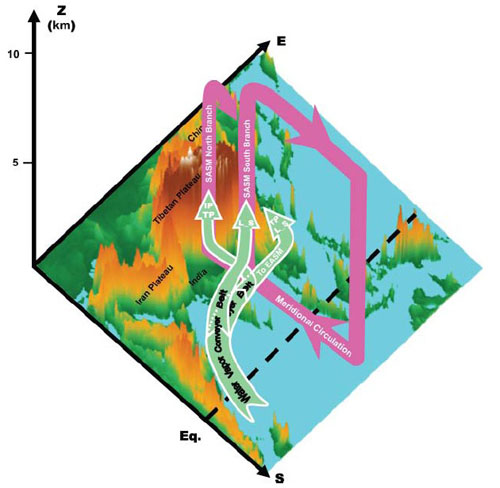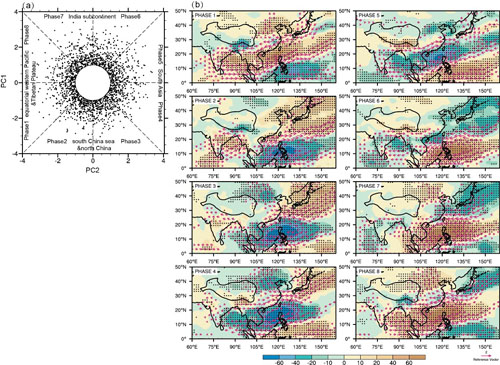The boreal summer intraseasonal oscillation (ISO) plays an important role in the evolution of the atmospheric circulation and the corresponding weather and climate anomalies. The Tibetan Plateau (TP), known as the “Third Pole”, is situated in the East Asian subtropical region and its mechanical and thermal effects on regulating the Asian summer monsoon have been widely studied (Figure 6 from Wu et al (2012)). However, on the intraseasonal timescale, a comprehensive understanding of the characteristics, origins, and effects of ISO over the TP will contribute to improving the ability of extended weather forecast over China.

Schematic diagram showing the gross structure of South Asian summe monsoon. [Fig 6 in (Wu et a, 2012)]
Drs. WANG Meirong and DUAN Anmin from the Institute of Atmospheric Physics (IAP/CAS), systematically analyzed the ISO over the TP and pointed out that the dominant intraseasonal signal was the quasi-biweekly oscillation (QBWO), which could be detected in circulation, precipitation and diabatic heating fields. In most cases, the QBWO over the TP originated from the equatorial western Pacific, propagated northwestward to the Bay of Bengal and northern India, then swung northward to the southeastern TP, and finally turned eastward to the East Asian area, showing a clockwise propagation pathway (Figure 1).

Figure.1 (a) Phase space representation of the state of the QBWO for the period 1979–2011. The state of the QBWO categorized as eight phases are used for the discussion. The approximate positions of the major negative convection areas in some phases are also denoted. (b) Composite life cycle of the QBWO (phases 1–8): filtered vertically integrated atmospheric apparent heat source (shaded; W m-2) and 500 hPa horizontal winds (vectors; m s-1). Significant vectors and dotted areas are at the 90% confidence level. (Figure plotted by IAP)
The main mechanisms for the northward-propagating of the QBWO signals were different in two stages. The first, in operation when the QBWO signals were located to the south of 20°N, was the generation of barotropic vorticity to the north of convection center induced by the easterly vertical shear, which further caused a moisture convergence in the planetary boundary layer, leading to the northward movement of the convection. The second mechanism, responsible for the propagation taking place further north towards the TP, was the moisture advection effect that destabilized the lower atmosphere ahead of the convection.
In addition, the paper also suggested that the QBWO linked the ISO of three monsoon subsystems (East Asian summer monsoon, South Asian summer monsoon, and TP summer monsoon). The paper has been published in Journal of Climate in 2015.
References
Wang. M. R., and A. M. Duan, 2015: Quasi-Biweekly Oscillation over the Tibetan Plateau and Its Link with the Asian Summer Monsoon. J. Climate, 28, 4921–4940.
Wu et al, 2012, Thermal Controls on the Asian Summer Monsoon, Scientific Reports, 404,doi: 10.1038/srep00404.
Contact: Dr. DUAN Anmin, amduan@lasg.iap.ac.cn







